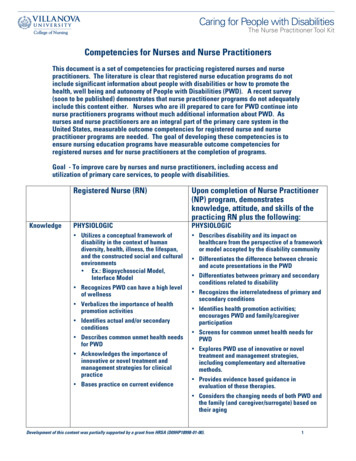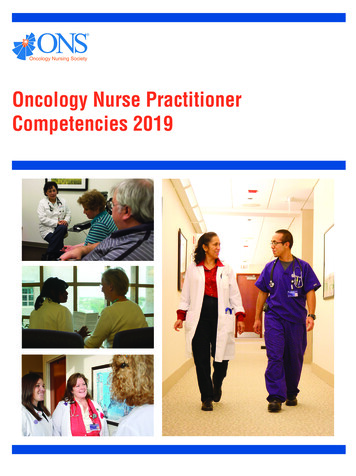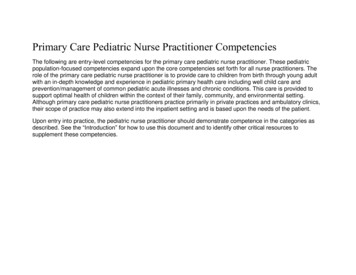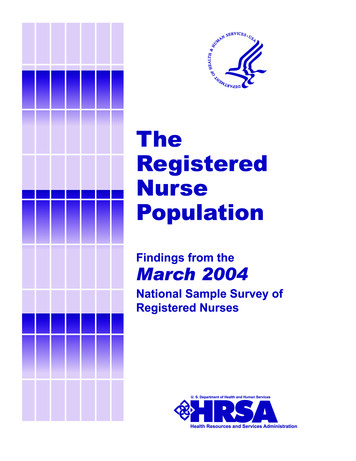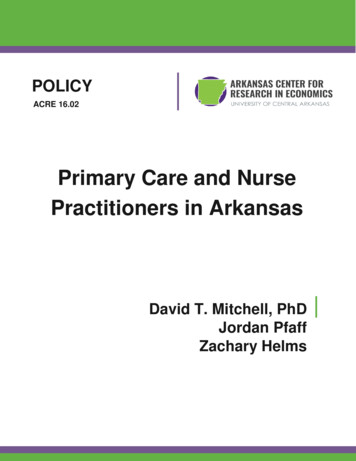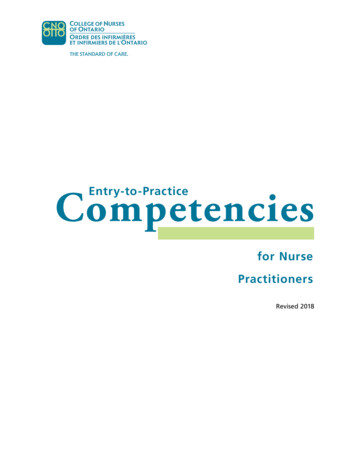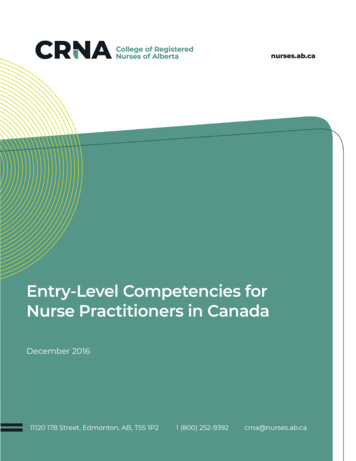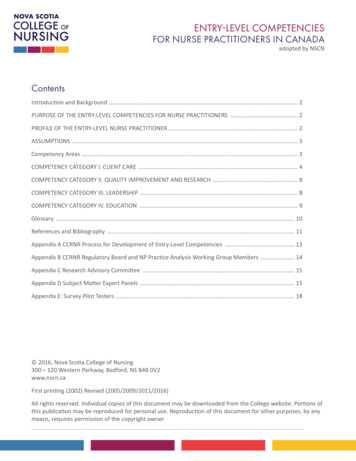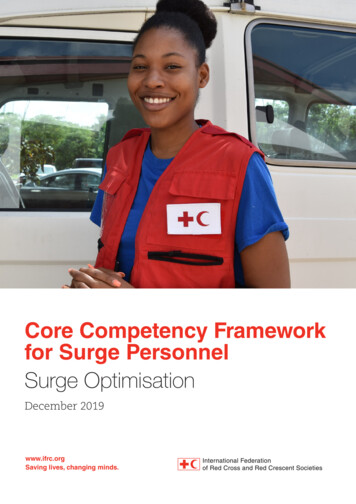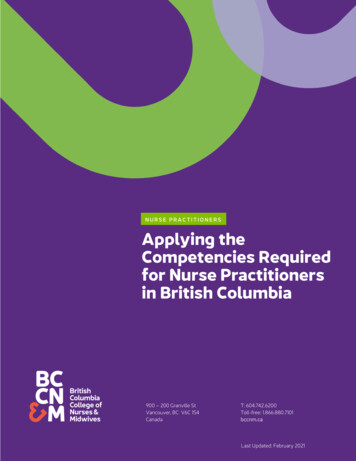
Transcription
NURSE PRACTITIONERSApplying theCompetencies Requiredfor Nurse Practitionersin British Columbia900 – 200 Granville StVancouver, BC V6C 1S4CanadaT: 604.742.6200Toll-free: 1.866.880.7101bccnm.caLast Updated: February 2021
APPLYING THE COMPETENCIES REQUIRED FOR NPs IN BRITISH COLUMBIAFOR NURSE PRACTITIONERSRevision LogRevision DateRevisions MadeApril 2018PublishedJanuary 2020Revised to reflect amalgamation of CollegesFebruary 2021Branding updated; references to BCCNP revisedto BCCNMBC COLLEGE OF NURSES AND MIDWIVES / 2
APPLYING THE COMPETENCIES REQUIRED FOR NPs IN BRITISH COLUMBIAFOR NURSE PRACTITIONERSTable of ContentsNP Competencies and Related Performance Indicators .4Introduction . 4About This Document . 4Terminology .5Context of Practice .5A Guiding Framework . 6Competence .6Competencies . 7Indicators . 8Knowledge, Skills and Abilities (KSAs) . 8Relating KSAs, Indicators and Competencies . 8Assumptions Related to NP Entry-Level Competencies .9Where Competencies Are Assessed .9Competency Category I. Client Care . 10A. Client Relationship Building and Communication . 10B. Assessment . 12C. Diagnosis. 16D. Management . 19E. Collaboration, Consultation, and Referral . 24F. Health Promotion . 26Competency Category II. Quality Improvement and Research . 28Competency Category III. Leadership . 30Competency Category IV. Education .32Client, Community, and Healthcare Team Education . 32Continuing Competence . 33Appendices. 34Appendix I: Entry-Level Competencies for Nurse Practitioners in Canada. 34Appendix II: NP Controlled Drugs and Substances (CDS) PRESCRIBING COMPETENCIES . 43Appendix III . 45Resources . 62BCCNM Resources . 62Other Resources. 62BC COLLEGE OF NURSES AND MIDWIVES / 3
APPLYING THE COMPETENCIES REQUIRED FOR NPs IN BRITISH COLUMBIAFOR NURSE PRACTITIONERSNP Competencies and Related Performance IndicatorsINTRODUCTIONIn December 2016, the College of Registered Nurses of British Columbia (now the British ColumbiaCollege of Nurses and Midwives or BCCNM) approved the new Entry-Level Competencies for NursePractitioners in Canada 1 for use in British Columbia. These national competencies are the result ofseveral years’ consultation by regulators of Nurse Practitioners across Canada. They replace theprevious competency document. 2To allow time for the necessary revisions to documents and processes, the college directed that thenational competencies would be implemented on the Nurse Practitioner OSCE examinationbeginning in June 2018 (OSCE27). Work required for implementation includes revisions to the: framework for assigning the competencies assessed in OSCE cases to OSCE Blueprintdomains; document Applying the Competencies Required for Nurse Practitioners in British Columbia; OSCE case writers’ guide; OSCE cases; scoring processes; and score profiles for candidates.ABOUT THIS DOCUMENTApplying the Competencies Required for Nurse Practitioners in British Columbia is intended to alignthe specific objective criteria for the OSCE with the new competencies, to enhance understanding ofthe elements of expected performance for the competencies. The document uses the nationalcompetencies as the defining framework and outlines the specific indicators that are used to assessperformance.Competencies cross boundaries of broad tasks and activities, so that a single competency can beassessed by several different tasks or activities. Similarly, a single task or activity can incorporateseveral competencies. As the task and activities on the OSCE are organized under Domains ofPractice, each domain can have many competencies.Competencies that are common to many tasks and activities (e.g., communication competencies) areassessed by the Global Assessment Scale (GAS) in the OSCE. The GAS evaluates thesecompetencies, and their underlying knowledge, skills, and abilities, across all stations.1Canadian Council of Registered Nurse Regulators (CCRNR). Entry-Level Competencies for Nurse Practitioners in Canada. Accessed:Jan. 10, 2020.2College of Registered Nurses of British Columbia. (2010). Competencies Required for Nurse Practitioners in British Columbia. Pub. no.416. Vancouver: Author.BC COLLEGE OF NURSES AND MIDWIVES / 4
APPLYING THE COMPETENCIES REQUIRED FOR NPs IN BRITISH COLUMBIAFOR NURSE PRACTITIONERSTERMINOLOGYSome of the terms that are used in the competencies, and in this document, have specific meanings.For a complete glossary of these terms, please see Entry-Level Competencies for NursePractitioners in Canada.The term ‘client’ is used throughout the competencies and this document. Clients are:“Individuals, families, groups, populations or entire communities who require nursingexpertise. The term “client” reflects the range of individuals and/or groups with whomnurses may be interacting. In some settings, other terms may be used such as patientor resident. In education, the client may also be a student; in administration, the clientmay also be an employee; and in research, the client is usually a subject or participant”(NANB, 2010a).In the OSCE, the client is an individual or family.The term ‘case’ is used throughout this document to identify the content for the interactive stationsand the PEP stations.In the OSCE, a ‘case’ is the content of an encounter or PEP station.In the OSCE, a ‘station’ is one of the encounters (e.g. 7T, 4C). A different case is assigned to thestation for subsequent exams.In the OSCE, a ‘room’ is the physical location of the station at the facility.CONTEXT OF PRACTICEWhile the competencies are the same for all Nurse Practitioners, each individual NP must interpretthe competencies relative to the context of practice. An NP who is competent in one context ofpractice may not be competent in a different context.There are three distinct streams of Nurse Practitioner practice in British Columbia (Family, Adult, andPediatric). Each stream has a different scope of practice with regard to the age of patients and thelocations where patients may be treated. Nurse Practitioners may restrict or specialize their practicewithin these streams to very narrow population types.Context of practice can therefore include the stream of practice, the work setting, the clientele orpopulation, and other factors. Each context of practice will have specific nuances that will shape theknowledge and skills used to support the achievement of a competency, and competence.BC COLLEGE OF NURSES AND MIDWIVES / 5
APPLYING THE COMPETENCIES REQUIRED FOR NPs IN BRITISH COLUMBIAFOR NURSE PRACTITIONERSA Guiding Framework 3CompetenceCompetenciesIndicatorsKnowledge, Skills, and Abilities(KSAs)COMPETENCECompetence is defined in the literature as:“ the habitual and judicious use of communication, knowledge, technical skills, clinicalreasoning, emotions, values, and reflection in daily practice for the benefit of theindividual and community being served Professional competence is developmental,impermanent, and context-dependent.” 4Similarly, BCCNM defines competence as:“The ability to integrate and apply the knowledge, skills, abilities and judgmentrequired to practise safely and ethically with a designated client population in aspecific nurse practitioner role and practice setting (CRNNS, 2011).” 5There is no known way to measure competence. Competence can, however, be broken down into aseries of measureable competencies.3This framework is adapted from Cane, D. (2013). Competencies, Indicators and Assessments. Presentation to CNNAR, October 2013.4Epstein, RM and Hundert, DM. (2002). In Cane, D. (2013). Competencies, Indicators and Assessments. Presentation to CNNAR, October2013.5Canadian Council of Registered Nurse Regulators (CCRNR). Entry-Level Competencies for Nurse Practitioners in Canada. Accessed:Jan. 10, 2020.BC COLLEGE OF NURSES AND MIDWIVES / 6
APPLYING THE COMPETENCIES REQUIRED FOR NPs IN BRITISH COLUMBIAFOR NURSE PRACTITIONERSCOMPETENCIESCompetencies can be thought of as facets of competence. They are broad statements intended todefine aspects of competence.The competencies document defines competencies as:“The specific knowledge, skills, abilities, and judgment required for a nurse practitionerto practice safely and ethically with a designated client population in a specific roleand practice setting (CRNNS, 2011).” 6At their most basic, competencies are the ability to perform a job task with a specified level ofproficiency. Job tasks can be concrete skills (e.g., auscultation) or more complex skills (e.g., synthesis,decision-making). All competencies are underpinned by their related knowledge, skills, and abilities.BCCNM has a separate list of competencies specifically related to Controlled Drugs and Substances(CDS). These are included in the approved Entry-Level Competencies for Nurse Practitioners inCanada as Appendix G. 7 (For the full list of these competencies, see Appendix II.)In the OSCE, CDS content is included in the relevant national competencies as follows:National CompetencyCDS CompetencyIA-7includes2-Ethical PracticeIB-2aincludes elements of3-AssessmentIB-3cincludes elements of3-AssessmentIC-1eincludes elements of5-DiagnosisIC-1iincludes elements of5-DiagnosisIC-2bincludes6-Knowledge cision Making in PrescribingID-3eincludes4-Identification and Managementof Risk Aberrant Drug RelatedBehaviours and HarmsID-7c6includes elements of3-AssessmentCanadian Council of Registered Nurse Regulators (CCRNR). Entry-Level Competencies for Nurse Practitioners in Canada. AccessedJan. 10, 2020.7College of Registered Nurses of British Columbia. Entry-Level Competencies for Nurse Practitioners in Canada. Accessed: January 3,2018.BC COLLEGE OF NURSES AND MIDWIVES / 7
APPLYING THE COMPETENCIES REQUIRED FOR NPs IN BRITISH COLUMBIAFOR NURSE PRACTITIONERSINDICATORSThere is often a need to break competencies down further for assessment purposes. Indicators aregiven for many competencies in order to define a level that is measurable through performance.“An indicator is a task that can be performed in an assessment vehicle, demonstrationof which provides an indication of proficiency in a competency.” 8Indicators provide specific criteria that are used to measure the actual performance of an individual.The varying number of indicators for each competency is related to the complexity of the task.KNOWLEDGE, SKILLS AND ABILITIES (KSAS)9KSAs are the foundation of NP practice. They overlap and support multiple competencies andmultiple indicators. KSAs include: Knowledge of anatomy; physiology; developmental and life stages; determinants of health;behavioural sciences; demographics; family process; diversity; cultural safety;pathophysiology; psychopathology; epidemiology; environmental exposure; infectiousdiseases; clinical manifestations of normal health events, acute illness/injuries, chronicdiseases; emergency health needs; comorbidities; pharmacotherapeutics; and evidenceinformed practice. Skill in performing interviews, observations, physical assessments and procedures, includingthe use of equipment and assessment or treatment tools; analyzing and synthesizinginformation; setting priorities and planning treatment; relaying clinical information; writingtreatment orders/prescriptions. Abilities in generic areas such as communication, problem-solving, and decision-making.A full mapping of KSAs to the related competencies is beyond the scope of this document.There are parts of the NP exam process (PEP stations, written exam) that specifically assessknowledge. Knowledge is also assessed in clinical stations, where candidates apply knowledge tospecific clinical situations.RELATING KSAS, INDICATORS AND COMPETENCIESIt is assumed that if a candidate demonstrates knowledge and skills and abilities (KSAs) at therequired standard for an entry-level practitioner (beginning practice NP) on the indicator tasks andactivities, he or she possesses the competency related to those indicators. Competencies thereforerely on KSAs, as well as on the associated indicators.It is further assumed that if a candidate has demonstrated sufficient competencies across thespectrum of those assessed on the OSCE, the candidate is competent at that point in time.8Cane, D. (2013). Competencies, Indicators and Assessments. Presentation to CNNAR, October 2013.9http://www.abbreviations.com/term/92019. Accessed July 3, 2017.BC COLLEGE OF NURSES AND MIDWIVES / 8
APPLYING THE COMPETENCIES REQUIRED FOR NPs IN BRITISH COLUMBIAFOR NURSE PRACTITIONERSSome competencies are assessed in the examination process, through the written exam, the OSCEinteractive checklist, the OSCE Global Assessment Scale (GAS) 10 and the OSCE PEP stations.Competencies may not be assessed in the exam process because they are better suited to anothertype of examination, or to on-the-job assessment. These competencies are still important to nursepractitioner practice, and they are included here for completeness.ASSUMPTIONS RELATED TO NP ENTRY-LEVEL COMPETENCIES 11The Nurse Practitioner Entry-level competencies are based on the following assumptions: NP practice is grounded in values, knowledge, and theories of nursing practice; Entry-level competencies form the foundation for all aspects of NP practice, and applyacross diverse practice settings and client populations; Entry-level competencies build and expand upon the competencies required of a registerednurse and address the knowledge, skills and abilities that are included in the NPs’ legislatedscope of practice; Nurse practitioners require graduate nursing education with a substantial clinical component; and Collaborative relationships with other healthcare providers involve both independent andshared decision making. All parties are accountable in the practice relationship asdetermined by their scopes of practice, educational backgrounds, and competencies.(For a list of the NP competencies, see Appendix I.)WHERE COMPETENCIES ARE ASSESSEDAll competencies are assessed in the Nurse Practitioner’s interactions with clients and with other healthcare providers throughout a career. However, there are specific competencies that are highlighted forassessment through different assessment tools, depending on the nature of the competencies involved.The regulatory assessment vehicles identified are: The written exam; The OSCE, which includes the interactive station checklists, the Global Assessment Scale(GAS), and the post-encounter probe (PEP) questions; The quality assurance program; and Assessment of substantial equivalence of internationally educated nurse practitioner applicants.While a specific competency is identified as being assessed using one of these assessment tools, it isunderstood that each competency may be assessed in multiple ways over the course of the nursepractitioner’s career. The notes on assessment are primarily for the use of exam candidates, to knowwhat might be covered on the OSCE exam.10As of this writing, the GAS categories are: Professional Conduct; Client-centred Care; Communication; Organization and Focus; Skill;and Decision Making.11Canadian Council of Registered Nurse Regulators (CCRNR). Entry-Level Competencies for Nurse Practitioners in Canada. Accessed:Jan. 10, 2020.BC COLLEGE OF NURSES AND MIDWIVES / 9
APPLYING THE COMPETENCIES REQUIRED FOR NPs IN BRITISH COLUMBIAFOR NURSE PRACTITIONERSCompetency Category I. Client CareA. CLIENT RELATIONSHIP BUILDING AND COMMUNICATIONThe competent, entry-level nurse practitioner uses appropriate communication strategies tocreate a safe and therapeutic environment for client care.Competency IA-1Clearly articulate the role of the nurse practitioner when interacting with the clientNot included in OSCECompetency IA-2Use developmentally and culturally-appropriate communication techniques and toolsOSCE – GASIndicators: Adapt to the communication style of the client Use techniques and strategies that are appropriate to the client presentation and inconsideration of client age and developmental stageCompetency IA-3Create a safe environment for effective and trusting client interaction where privacy andconfidentiality are maintainedOSCE – GASIndicators: Communicate with the client in accordance with privacy and protection laws Encourage the client to feel at ease Treat the client respectfully Gather information respectfully and sensitively Maintain the client relationship through appropriate verbal communication during theexamination Acknowledge the client’s health status and concernsCompetency IA-4Use relational strategies (e.g., open-ended question, fostering partnerships) to establish therapeuticrelationshipsOSCE – GASBC COLLEGE OF NURSES AND MIDWIVES / 10
APPLYING THE COMPETENCIES REQUIRED FOR NPs IN BRITISH COLUMBIAFOR NURSE PRACTITIONERSIndicators: Encourage the client to voice and address concerns Encourage the client to describe his/her situation, feelings, concerns and attitudes Encourage the client to describe the meaning of his/her health/illness experience and howhis/her daily living is affected Provide information and make recommendations in a manner that encourages participation,understanding and learningIn the OSCE, these activities are expected to the extent possible in the time available.Competency IA-5Provide culturally-safe care, integrating client’s cultural beliefs and values in all clientinteractionsOSCE – GASIndicators: Consider culture and determinants of health as appropriate Implement health promotion/prevention strategies to reflect the client’s unique attributeswith attention to cultural safetyCompetency IA-6Identify personal beliefs and values and provide unbiased careNot included in OSCECompetency IA-7Recognize moral or ethical dilemmas, and take appropriate action if necessary (e.g., consult withothers, involve legal system)OSCE – GASIndicators: Practice in accordance with ethical and professional standardsCompetency IA-8Document relevant aspects of client care in client recordNot included in OSCEBC COLLEGE OF NURSES AND MIDWIVES / 11
APPLYING THE COMPETENCIES REQUIRED FOR NPs IN BRITISH COLUMBIAFOR NURSE PRACTITIONERSB. ASSESSMENTThe competent, entry-level nurse practitioner integrates an evidence-informed knowledge basewith advanced assessment skills to obtain the necessary information to identify clientdiagnoses, strengths and needs.Competency IB-1Establish the reason for the client encounterIB-1a: Review information relevant to the client encounter (e.g., referral information, information fromother healthcare providers, triage notes) if availableOSCE - Interactive/PEPIndicators: Analyze and interpret information from appropriate sources, including Clinical Informationand Instructions for CandidateIB-1b: Perform initial observational assessment of the client’s conditionOSCE – InteractiveIndicators: Assess client’s demeanor, appearance, and/or behaviourIn the OSCE, observational activities must be verbalized by the candidate so that the examinerknows what is being observed.IB-1c: Ask pertinent questions to establish the context for client encounter and chief presenting issueOSCE - InteractiveIndicators: Seek clarification when necessary to enhance understandingIB-1d: Identify urgent, emergent, and life-threatening situationsOSCE - Interactive/PEPIndicators: Ask questions to identify urgent, emergent and life threatening situations Recognize urgent and emergent health needsIB-1e: Establish priories of client encounterOSCE – Interactive/PEPBC COLLEGE OF NURSES AND MIDWIVES / 12
APPLYING THE COMPETENCIES REQUIRED FOR NPs IN BRITISH COLUMBIAFOR NURSE PRACTITIONERSIndicators: Establish health care goals collaboratively responding to needs, trends, patterns or identified risksCompetency IB-2Complete relevant health history appropriate to the client’s presentationIB-2a: Collect health history including symptoms, history of presenting issue, past medical andmental health history, family health history, pre-natal history, growth and development history,sexual history, allergies, prescriptions and OTC medications, and complementary therapiesOSCE – InteractiveIndicators: Use a method of history taking that is appropriate to the client’s presenting concern Gather information in a standard, systematic and organized manner Gather information respectfully and sensitively Seek clarification when necessary to enhance understandingSome of the required data may be provided in the Clinical Information.IB-2b: Collect relevant information specific to the client’s psychosocial, behavioural, cultural, ethnic,spiritual, developmental life stage, and social determinants of healthOSCE – InteractiveIndicators: Gather information in a standard, systematic and organized manner Gather information respectfully and sensitively Seek clarification when necessary to enhance understandingSome of the required data may be provided in the Clinical Information.IB-2c: Determine the client’s potential risk profile or actual risk behaviours (e.g., alcohol, illicit drugsand/or controlled substances, suicide or self-harm, abuse or neglect, falls, infections)OSCE - Interactive/PEPIndicators: Gather information to determine risk profile Seek clarification when necessary to enhance understandingIn the OSCE, findings must be verbalized by the candidate for the examiner.IB-2d: Assess client’s strengths and health promotion, illness prevention, or risk reduction needsOSCE - Interactive/PEPBC COLLEGE OF NURSES AND MIDWIVES / 13
APPLYING THE COMPETENCIES REQUIRED FOR NPs IN BRITISH COLUMBIAFOR NURSE PRACTITIONERSIndicators: Anticipate health promotion and injury prevention needs based on evidence-informedguidelines Gather information to elicit health promotion and injury prevention needs of clientIn the OSCE, findings must be verbalized by the candidate for the examinerCompetency IB-3Perform assessmentIB-3a: Based on the client’s presenting condition and health history, identify level of assessment(focused or comprehensive) required, and perform review of relevant systemsOSCE – Interactive/GASIndicators: Assesses related systems where indicated to obtain informationIB-3b: Select relevant assessment tools and techniques to examine the clientOSCE - Interactive/PEPIndicators: Choose appropriate assessments for the client’s condition Indicate intention to perform a specific techniqueIB-3c: Perform a relevant physical examination based on assessment findings and specific clientcharacteristics (e.g., age, culture, developmental, level, functional ability)OSCE – InteractiveIndicators: Perform physical examinations to identify urgent, emergent and life threatening situations,as well as part of a routine assessment Perform physical examinations that are congruent with the history and assessment findingsand are comprehensive and appropriate to differential diagnosis Perform physical examinations in keeping with standardized and accepted practice Perform examination in a systematic and organized manner with minimal discomfort to theclient Provide clear instruction to the client about the examinationCandidates are expected to set priorities for physical examinations on the basis of the history andother information provided at the start of the station or during the station.In the OSCE, focused (rather than comprehensive) physical assessments are expected.BC COLLEGE OF NURSES AND MIDWIVES / 14
APPLYING THE COMPETENCIES REQUIRED FOR NPs IN BRITISH COLUMBIAFOR NURSE PRACTITIONERSIB-3d: Assess mental health, cognitive status, and vulnerability using relevant assessment toolsOSCE - InteractiveIndicators: Perform assessments in keeping with standardized and accepted practice Provide clear instruction to the client when necessaryAssessment tools are provided where necessary. Candidates are reminded to bring their ownstethoscopes.IB-3e: Integrate laboratory and diagnostic results with history and physical assessment findingsOSCE - Interactive/PEPIndicators:Analyze and interpret information from appropriate sources, including information provided inCandidate Instruction, by the Examiner, or in the PEPBC COLLEGE OF NURSES AND MIDWIVES / 15
APPLYING THE COMPETENCIES REQUIRED FOR NPs IN BRITISH COLUMBIAFOR NURSE PRACTITIONERSC. DIAGNOSISThe competent, entry-level nurse practitioner is engaged in the diagnostic process and developsdifferential diagnoses through identification, analysis, and interpretation of findings from avariety of sources.Competency IC-1Determine differential diagnoses for acute, chronic, and life-threatening conditionsIC-1a: Analyze and interpret multiple sources of data, including results of diagnostic and screeningtests, health history, and physical examinationOSCE – GASIndicators: Analyze and interpret information from appropriate sources Identify and accurately interpret both normal and abnormal findings, as appropriate to clientpresentationInformation can be obtained from Clinical Information, from the client, from the Examiner, or fromother information provided in the interactive or PEP station.The Examiner may be instructed to confirm normal or abnormal findings.IC-1b: Synthesize assessment findings with scientific knowledge, determinants of health, knowledgeof normal and abnormal states of health/illness, patient and population-level characteristics,epidemiology, health risksOSCE – PEP/GASIndicators: Use knowledge to interpret assessment findings Provide rationale for assessment, diagnosis, and/or diagnostic reasoningIC-1c: Generate differential diagnosesOSCE - Interactive/PEPIndicators: Formulate differential diagnoses that are based on critical inquiry and reflect sound clinicalreasoning Formulate differential diagnoses that are accurate and comprehensiveIC-1d: Inform the patient of the rationale for ordering diagnostic testsOSCE – GASBC COLL
The Nurse Practitioner Entry-level competencies are based on the following assumptions: NP practice is grounded in values, knowledge, and theories of nursing practice; Entry-level competencies form the foundation for all aspects of NP practice, and apply . client .


